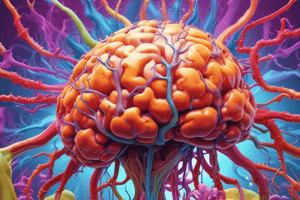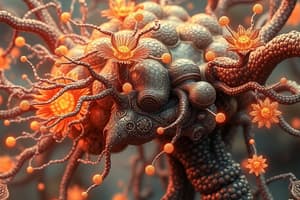Podcast
Questions and Answers
What is the key ingredient for creating both intracellular and extracellular fluid?
What is the key ingredient for creating both intracellular and extracellular fluid?
Water
What is the term for a molecule with a net electrical charge?
What is the term for a molecule with a net electrical charge?
Ion
Name the two types of ions based on their charge and provide an example of each.
Name the two types of ions based on their charge and provide an example of each.
Cations are positively charged, such as sodium ion (Na+). Anions are negatively charged, such as chloride ion (Cl-).
What is the primary component of the plasma membrane in neurons?
What is the primary component of the plasma membrane in neurons?
What is the role of protein molecules in the neuronal membrane?
What is the role of protein molecules in the neuronal membrane?
Explain the concept of diffusion in relation to the movement of ions.
Explain the concept of diffusion in relation to the movement of ions.
State Ohm's Law and define the variables used.
State Ohm's Law and define the variables used.
What is the relationship between conductance (g) and resistance (R)?
What is the relationship between conductance (g) and resistance (R)?
Describe the distribution of potassium ions (K+), sodium ions (Na+), and calcium ions (Ca2+) across the neuronal membrane in the resting state.
Describe the distribution of potassium ions (K+), sodium ions (Na+), and calcium ions (Ca2+) across the neuronal membrane in the resting state.
What is the Nernst Equation and what does it calculate?
What is the Nernst Equation and what does it calculate?
What is the function of the sodium-potassium pump in maintaining the resting membrane potential?
What is the function of the sodium-potassium pump in maintaining the resting membrane potential?
What is the role of the calcium pump in neuronal function?
What is the role of the calcium pump in neuronal function?
Explain the concept of the equilibrium potential (Eion) and its significance in neuronal function.
Explain the concept of the equilibrium potential (Eion) and its significance in neuronal function.
What are the four key points to understand about the relationship between Vm, Eion, and ionic concentrations?
What are the four key points to understand about the relationship between Vm, Eion, and ionic concentrations?
Which type of ion channel plays a major role in determining the resting membrane potential?
Which type of ion channel plays a major role in determining the resting membrane potential?
What is the blood-brain barrier and how does it relate to regulating the external potassium concentration?
What is the blood-brain barrier and how does it relate to regulating the external potassium concentration?
What are the main factors that contribute to the resting membrane potential?
What are the main factors that contribute to the resting membrane potential?
Flashcards
Neuronal excitability
Neuronal excitability
The ability of neurons to respond to stimuli and convert them into electrical signals.
Ionic flow
Ionic flow
Movement of ions across neural membranes, vital for signal transmission.
Resting membrane potential
Resting membrane potential
The voltage difference across the neuronal membrane at rest, typically around -70 mV.
Cation
Cation
Signup and view all the flashcards
Anion
Anion
Signup and view all the flashcards
Nernst Equation
Nernst Equation
Signup and view all the flashcards
Sodium-potassium pump
Sodium-potassium pump
Signup and view all the flashcards
Equilibrium potential (Eion)
Equilibrium potential (Eion)
Signup and view all the flashcards
Diffusion
Diffusion
Signup and view all the flashcards
Ion selectivity
Ion selectivity
Signup and view all the flashcards
Phospholipid bilayer
Phospholipid bilayer
Signup and view all the flashcards
Electrical conductance (g)
Electrical conductance (g)
Signup and view all the flashcards
Action potential
Action potential
Signup and view all the flashcards
Concentration gradient
Concentration gradient
Signup and view all the flashcards
Potassium channels
Potassium channels
Signup and view all the flashcards
Study Notes
Course Information
- Course Title: Principle of Neurobiology
- Course Code: BIO 3350
- Semester: Winter 2025
- Instructor: Jean-Claude Béïque
- Email: [email protected]
Neuronal Excitability - Outline
- Ionic bases of neuronal excitability
- Ionic flow through channels
- Ionic basis of the resting membrane potential
Scales of Neural Organization
- Macroscale
- Mesoscale
- Microscale
Neurons as Input-Output Machines
- Input: Dendrites
- Output: Axon
- Functionality: Connectivity, Transformation, Neural Code
The Cast of Chemicals
- Cytosolic and Extracellular Fluid: Primarily water
- Water is a polar solvent
- Ions: Atoms/molecules with an electrical charge
- Cations: positive charge
- Anions: negative charge
- Spheres of hydration
- Phospholipid Membrane: Phospholipid bilayer
- Polar head (phosphate)
- Nonpolar tail (hydrocarbon)
- Channel Proteins: Proteins that form channels across the membrane
- Polar and nonpolar R groups
- Ion selectivity
- Ion gating
Movement of Ions
- Diffusion: Dissolved ions distribute evenly
- Ions flow down gradient if channels are permeable
- Concentration gradient across the membrane is key
- Electrical current flow
- Ohm's law: V = IR or I = gV
- Electrical conductance (g) and resistance (R)
- R = 1/g
The Ionic Basis of the Resting Membrane Potential
- Ion Distribution:
- K+ is more concentrated inside the cell
- Na+ and Ca2+ are more concentrated outside
- A concentration ratio for each ion (e.g., K+: 1:20)
- A potential in mV for each ion at 37°C (e.g., K+ at -80 mV)
- Nernst Equation: Calculates equilibrium potential
- Considers ion charge, temperature, and concentration ratios.
- Formula provided: E = (RT/zF)ln([ion outside cell]/[ion inside cell])
- Sodium-Potassium Pump: Enzyme breaks down ATP, moves Na+ out and K+ in (actively transports ions)
- Calcium Pump: Actively transports Ca2+ out of the cytosol.
- Equilibrium Potential: Potential difference at which there's no net movement of ions across the membrane
- Significance: Potassium channels are crucial in establishing resting membrane potential
- Permeability: Selective permeability of potassium channels determines the resting membrane potential
Other Key Concepts
- Four important points about equilibrium potentials
- Resting Membrane potential is proportional to the equilibrium potential
- Relative ion permeabilities of the membrane at rest
- How the resting membrane potential relates to the concentration gradient of ions
- How potassium channels work
- How the blood-brain barrier and potassium spatial buffering relate to the resting potential.
Studying That Suits You
Use AI to generate personalized quizzes and flashcards to suit your learning preferences.




